Assessing the Composting Potential of Corn Husks
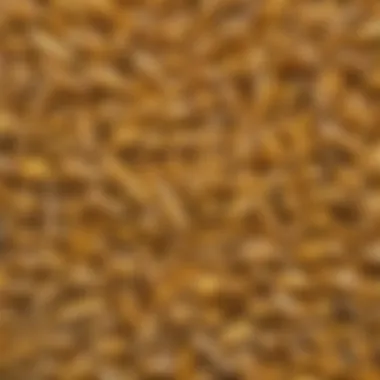

Intro
Composting plays a vital role in sustainable agriculture, contributing to nutrient recycling and enhancing soil health. Among the various organic materials, corn husks are often overlooked despite their potential benefits in composting systems. This article presents a thorough examination of corn husks, their compostability, and the numerous factors to consider for effective integration into composting practices. Through this exploration, one can better understand the decomposition processes, advantages, challenges, and best practices surrounding the use of corn husks in compost systems.
Overview of the Topic
Definition and Importance
Corn husks are the outer leaves that encase the corn ear. They are generally a byproduct of corn production, often discarded during the harvesting and processing stages. However, their fibrous structure and rich organic content make them an important component of compost. Understanding the composition and breakdown of corn husks can help promote sustainable waste management within agricultural contexts. Their inclusion in compost can improve the carbon-to-nitrogen ratio, aiding in the creation of nutrient-rich soil amendments.
Current Trends
Today, there is a growing emphasis on using agricultural byproducts for sustainable practices. Farmers and agricultural enthusiasts are discovering the value of composting materials like corn husks, as they contribute positively to soil health and ecological balance. This trend aligns with broader global movements towards reducing waste and optimizing resource use. The challenge lies in properly evaluating these materials and effectively incorporating them into compost systems to maximize their benefits.
Key Techniques and Practices
Step-by-Step Guide
- Collection: Gather corn husks immediately after harvesting corn to prevent spoilage.
- Shredding: Reduce the size of the husks for quicker decomposition. Smaller particles decompose faster than larger ones.
- Mixing: Combine corn husks with other compost materials rich in nitrogen, such as kitchen scraps or manure, to achieve an optimal balance.
- Moisture: Maintain adequate moisture levels in the compost pile to facilitate the microbial activity essential for decomposition.
- Aeration: Regularly turn the compost to ensure aeration, which is critical for the aerobic decomposition process.
- Monitoring: Keep track of temperature and moisture over time, making adjustments as needed to achieve efficient composting.
Tools and Equipment Needed
To effectively compost corn husks, certain tools are useful:
- Shredding machine or garden mulcher
- Compost bin or pile setup
- Moisture meter to monitor levels
- Pitchfork or shovel for turning the compost
- Thermometer to check compost temperature
Challenges and Solutions
Common Obstacles
Despite their benefits, composting corn husks may present some challenges:
- Decomposition Rate: Corn husks tend to decompose slower due to their fibrous texture.
- C/N Ratio: If not mixed properly, the carbon-rich husks could lead to a high carbon-to-nitrogen ratio, inhibiting composting.
Innovative Solutions
To counter these obstacles, consider the following solutions:
- Pre-soaking: Soaking corn husks in water before adding to the compost can speed up decomposition.
- Combining with Green Materials: Use nitrogen-rich greens to balance the compost mix and facilitate faster breakdown.
"Incorporating corn husks into compost systems not only reduces waste but also enhances soil structure and fertility."
Understanding the compostability of corn husks is essential to promote their use in sustainable agricultural practices. As farmers and enthusiasts look to waste reduction, evaluating and adopting proper composting techniques will be critical for transforming corn husks into valuable compost. This process not only benefits individual farms but also contributes to the broader goal of sustainable agriculture.
Foreword
The evaluation of corn husks for composting is a significant topic within sustainable agricultural practices. Corn husks are a byproduct of corn production, and their potential for composting merits closer examination. Understanding how these materials can contribute to soil health and nutrient cycling is essential for farmers and environmental enthusiasts alike.
This article aims to dissect the various aspects of corn husks as compostable material, delving into their physical and chemical characteristics. By evaluating the benefits and challenges associated with composting corn husks, the article seeks to provide comprehensive insights.
Key Points of Discussion
- Physical Properties: Analyzing the fiber composition, moisture content, and nutrient profile of corn husks.
- Decomposition Process: Understanding how corn husks break down within compost systems.
- Benefits: Recognizing how composting corn husks can enhance soil fertility and contribute to waste reduction.
- Challenges: Addressing issues such as decomposition speed and potential contaminants that may arise.
- Best Practices: Offering techniques for preparing and incorporating corn husks into compost systems effectively.
Through this exploration, the article underscores the importance of corn husks in creating effective compost systems and their broader implications for sustainable farming. Ultimately, understanding the compostability of corn husks can influence agricultural practices positively, enhancing soil quality and promoting environmental stewardship.
Understanding Composting
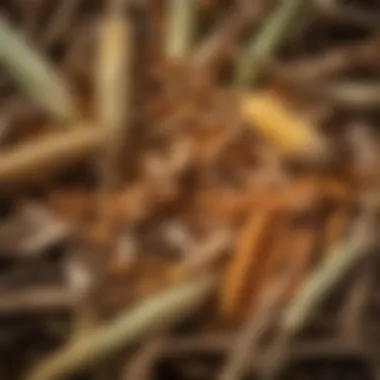
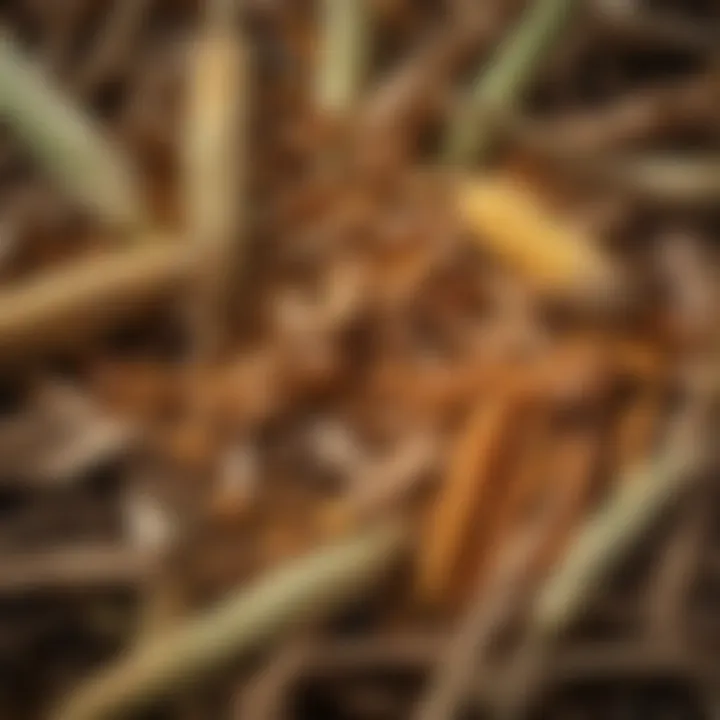
Composting Defined
Composting is the natural decomposition of organic materials, facilitated by microorganisms. The process, when executed properly, leads to a dark, crumbly substance known as compost. Compost serves as an excellent amendment for gardens and farmlands. It improves soil structure, increases microbial activity, and enables better water retention. A solid definition of composting allows farmers and enthusiasts to appreciate its value in managing agricultural waste effectively.
The Composting Process
The composting process involves several key steps that promote the breakdown of organic matter. Understanding this process is essential for evaluating corn husks' compostability.
Microbial Activity
Microbial activity is the heart of composting. Beneficial microbes break down materials, converting them into useful compost. They thrive in environments rich in moisture and organic matter. The key characteristic of microbial activity is its efficiency. This process can dramatically speed up the decomposition of corn husks. A unique feature is the ability to adapt to varying conditions. For instance, some microbes can survive in low-oxygen environments, contributing to composting even in challenging settings. However, an overly acidic environment can hinder microbial function, which is a disadvantage to note.
Temperature Management
Temperature management is crucial in the composting process. Microbial activity generates heat, raising the temperature of the compost pile. Maintaining an optimal temperature range of 130 to 160 degrees Fahrenheit helps control pathogens and weed seeds. Temperature also affects decomposition speed; higher warmth generally accelerates the process. A notable advantage of temperature management is its role in creating a conducive environment for beneficial microbes. However, it requires monitoring, as temperatures that are too high may kill off these essential organisms.
Carbon to Nitrogen Ratio
The carbon to nitrogen ratio (C:N ratio) is a significant aspect of composting. This ratio speaks to the balance between carbon-rich materials, such as corn husks, and nitrogen-rich materials, like food scraps. A balanced C:N ratio, typically around 30:1, encourages effective decomposition. The primary characteristic of this ratio is its impact on microbial activity. If the ratio is off, decomposition can slow drastically, resulting in unpleasant odors and an inefficient process. Understanding how to manage this ratio is fundamentally beneficial for composting corn husks. It ensures that they break down effectively while enhancing overall compost quality.
Corn Husks: An Overview
The examination of corn husks in the context of compostability is essential for understanding their role in sustainable agricultural practices. Corn husks, a byproduct of corn production, represent a significant waste material that farmers and agricultural enthusiasts can utilize effectively. By integrating corn husks into compost systems, we can enhance soil health, reduce waste, and promote nutrient recycling. Understanding the characteristics of corn husks is crucial, and this section aims to outline their composition and the factors influencing their decomposition.
Composition of Corn Husks
Fibers
Fibers constitute a major element of corn husks. These fibers are primarily composed of cellulose, hemicellulose, and lignin. One key characteristic of these fibers is their strength, which allows them to withstand mechanical stress. Moreover, the fibrous nature offers excellent structural support when mixed into compost. This aspect is beneficial as it contributes to aeration in the compost, facilitating microbial activity essential for decomposition.
A unique feature of the fibers in corn husks is their relatively slow breakdown rate compared to softer green materials. This can be both an advantage and a disadvantage. While the gradual decomposition contributes to long-term soil structure and stability, it can also slow down the overall composting process if not balanced properly with other materials.
Moisture Content
The moisture content of corn husks plays a significant role in their compostability. Corn husks generally have a moisture content ranging from 10% to 15%. This moderate level is considered advantageous as it helps maintain an optimal environment for microbial activity. Adequate moisture levels prevent the compost from becoming too dry, which is essential for sustaining microbial populations.
However, corn husks can retain excess moisture if not managed correctly. This can lead to anaerobic conditions in the compost pile, resulting in unpleasant odors and slow decomposition. Therefore, monitoring and adjusting moisture content is a critical consideration when composting corn husks.
Nutrients
Corn husks offer a unique array of nutrients, primarily calcium, magnesium, and potassium. These nutrients contribute positively to soil fertility. The nutrient content is one of the most compelling reasons for farmers to consider composting corn husks.
Notably, corn husks have a high carbon-to-nitrogen ratio, typically around 60:1. This ratio indicates that while husks supply carbon, they also need an adequate source of nitrogen for effective composting. Thus, while they improve nutrient availability, an imbalance may hinder decomposition speed. Therefore, balancing corn husks with nitrogen-rich materials is essential for efficient composting.
Characteristics Affecting Decomposition
The decomposition rate of corn husks is influenced by several intrinsic and extrinsic factors. The inherent lignin content be a significant contributor to their durability within compost systems. Lignin is known for its resistance to microbial attack, meaning it can prolong decomposition times. Additionally, environmental factors such as climate conditions, temperature fluctuations, and moisture levels heavily impact how quickly corn husks break down.
Important Note: The successful composting of corn husks requires careful consideration of their composition and characteristics. Understanding these elements allows for better integration into sustainable composting practices.
Can Corn Husks Be Composted?
When considering sustainable agricultural practices, understanding the compostability of corn husks is crucial. Corn husks are a byproduct of corn production, and their potential to be composted can enhance waste management efforts. If utilized correctly, they can contribute significantly to the composting process. This section addresses the importance of corn husks in compost systems, covering key insights from scientific research and practical strategies for incorporation.
Scientific Perspectives
Research Findings
Recent studies indicate that corn husks possess suitable qualities for composting. Research shows they are rich in cellulose, which contributes to microbial activity during decomposition. The breakdown of corn husks increases the organic matter in compost, leading to a nutrient-rich end product. This characteristic makes them a beneficial addition to compost heaps. However, the high fiber content means that corn husks can take longer to decompose than other materials like vegetable scraps.
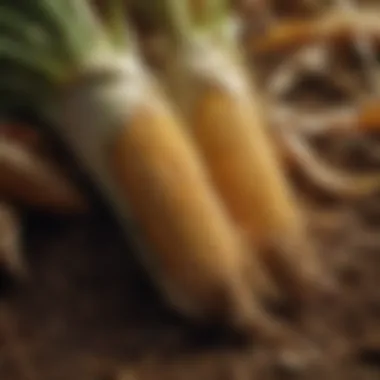
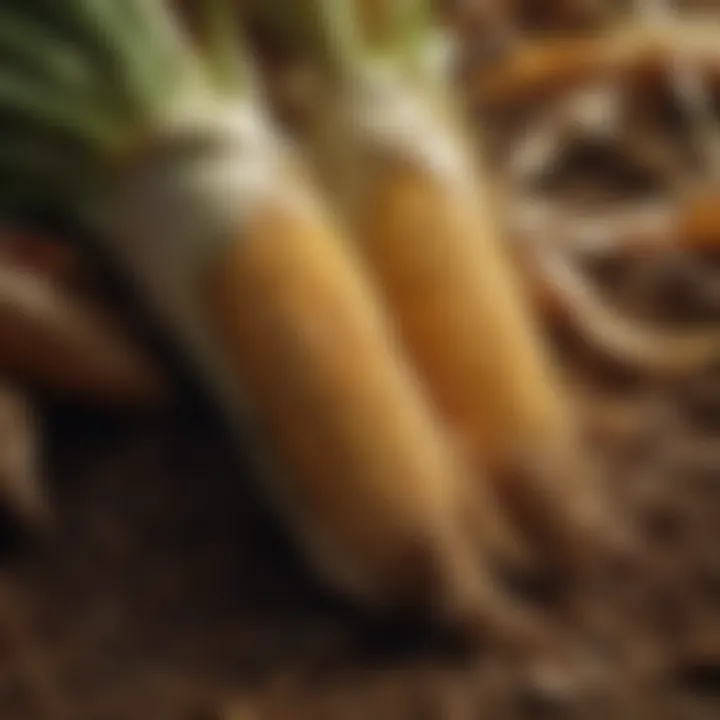
"Incorporating corn husks into compost not only improves soil quality but also helps reduce agricultural waste."
Expert Opinions
Agricultural experts frequently cite corn husks as valuable for composting. Their opinions highlight that while corn husks are not as rapidly decomposable as grass clippings or leaves, their long-term benefits outweigh the slower breakdown rate. Experts recommend mixing corn husks with faster-decomposing materials to achieve a balanced compost system. This unique blending strategy maximizes the advantages of all components involved.
Composting Corn Husks: Practical Considerations
Preparation Techniques
Preparing corn husks for composting involves several actions. Shredding the husks helps increase their surface area, accelerating decomposition. This technique allows microorganisms easier access to the material, thus enhancing the composting process. Additionally, adjusting moisture levels is vital. Corn husks can sometimes retain excessive moisture, which can lead to anaerobic conditions and odor issues. Therefore, balancing moisture content is a well-regarded preparation technique.
Mixing Ratios
The right mixing ratios are key when composting corn husks. For optimal decomposition, it is often recommended to combine corn husks with high-nitrogen materials like kitchen scraps or grass clippings. The ideal carbon to nitrogen ratio is around 30:1, ensuring that composting bacteria have enough nitrogen to thrive. By adhering to these ratios, farmers can achieve better results in compost quality. Alternatively, using too many corn husks can lead to a low-nitrogen compost that compacts and decomposes slowly.
Benefits of Composting Corn Husks
Composting corn husks offers numerous advantages, particularly in promoting sustainable agricultural practices. Understanding these benefits can guide farmers and enthusiasts in adopting better waste management strategies while enhancing the ecosystems in which they operate.
Soil Enrichment
Corn husks are rich in organic matter, which plays a crucial role in improving soil quality. When incorporated into compost, they contribute to the formation of humus, a stable form of decomposed organic material. This aids soil structure, fostering better aeration and water retention. Here are some specific benefits:
- Nutrient Supply: Corn husks provide essential nutrients like nitrogen, phosphorus, and potassium. These elements are critical for plant growth. As they decompose, they release these nutrients, making them available for crops.
- Microbial Activity: The decomposition of corn husks stimulates microbial activity in the soil. This is vital, as microbes break down organic material further, enriching the soil and improving its overall health.
- Acid Neutralization: Decomposing organic matter can help neutralize acidic soils. This creates a more balanced pH, promoting better conditions for plant roots.
In summary, the incorporation of corn husks into compost enhances soil fertility and creates a thriving environment for beneficial organisms. This ultimately leads to healthier crop yields, making composting a beneficial practice for sustainable agriculture.
Waste Reduction
Another significant benefit of composting corn husks is waste reduction. As agricultural byproducts, corn husks are often discarded, contributing to landfill overflow and environmental degradation. Composting is a practical solution for addressing this issue. Key points include:
- Minimizing Landfill Waste: By composting corn husks, farmers can significantly reduce the volume of organic waste sent to landfills. This not only conserves space in landfills but also decreases greenhouse gas emissions associated with organic waste decomposing in anaerobic conditions.
- Closing the Loop: Composting supports a circular economy. The byproducts of one agricultural process become resources for another. By returning corn husks to the soil, farmers can sustain the nutrient cycle.
- Cost Efficiency: Managing waste effectively can lead to cost savings. Farmers who compost can reduce disposal fees and even rely less on synthetic fertilizers, thus lowering overall production costs.
Challenges in Composting Corn Husks
Composting corn husks presents unique challenges that require the attention of both farmers and enthusiasts. Understanding these challenges is essential for optimizing compost systems and ensuring that corn husks can contribute positively to soil health. Evaluating the difficulties in the composting process allows us to be better prepared and to enhance the overall efficacy of composting practices.
Decomposition Speed
The decomposition speed of corn husks can be a significant barrier in the composting process. Corn husks are primarily composed of tough fibers that tend to break down slowly. Depending on environmental conditions, it might take longer for these fibers to fully decompose compared to other compostable materials like fruit and vegetable scraps. Factors that influence the decomposition speed include:
- Particle Size: The size of the corn husks affects their surface area and, consequently, the rate at which microbes can access and process the material. Smaller pieces tend to compost faster.
- Moisture Levels: Adequate moisture is critical for microbial activity. If corn husks are too dry, they will not decompose efficiently. Conversely, excessive moisture can lead to anaerobic conditions, which hinder composting.
- Microbial Activity: Healthy microbial populations are necessary for the decomposition of any organic material. If the compost pile lacks diverse microbes or if the temperature is not optimal, it can slow down the breakdown of corn husks.
Addressing these factors can help in achieving a more reasonable decomposition timeline for corn husks within compost systems.
Potential Contaminants
Another crucial issue when composting corn husks involves the potential for introducing contaminants into the compost pile. Contaminants can come from different sources, and their presence may undermine the quality of the final compost product. Key considerations include:
- Pesticide Residues: Corn is often treated with various pesticides to protect it against pests and diseases. If not managed properly, these residues can transfer into the compost and later into the soil, as well as crops grown in that soil.
- Weed Seeds: Corn husks may carry seeds from weeds. If these seeds survive the composting process, they can germinate when the compost is applied to gardens or fields, creating additional challenges for farmers.
- Pathogens and Diseases: There is also a risk of pathogens existing on corn husks. If pathogens are present and not killed off during the composting process, they could pose a threat to vegetable crops
Addressing these potential contaminants involves thorough sourcing, proper treatment of corn husks before composting, and careful monitoring of the composting environment.
Understanding these challenges allows growers to implement best practices and adopt a more strategic approach to composting corn husks, ultimately enhancing soil health and agricultural productivity.
Best Practices for Composting Corn Husks
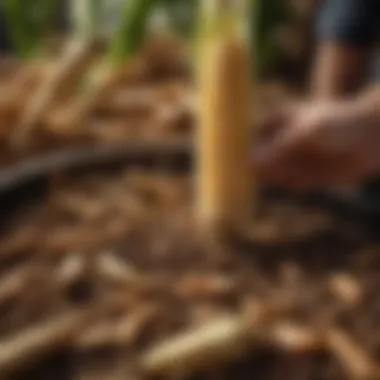
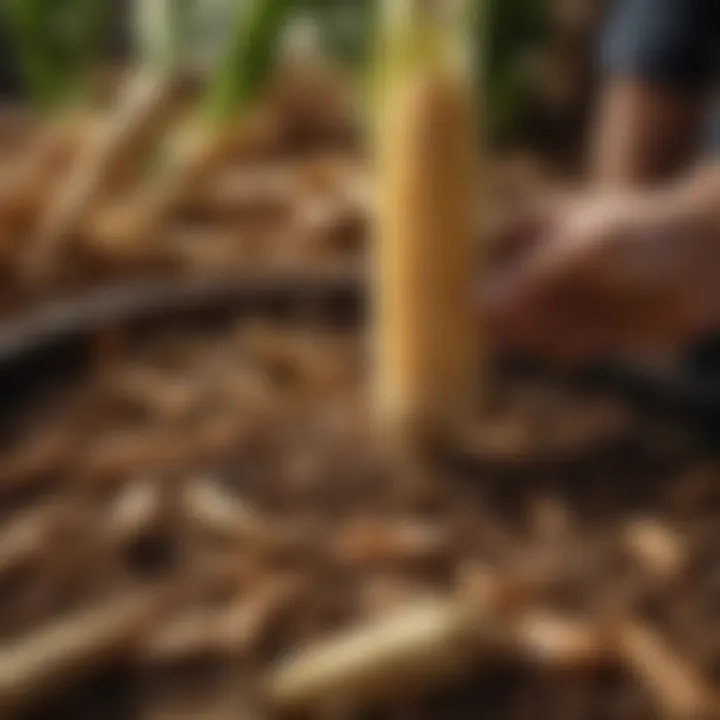
Best practices for composting corn husks are crucial for achieving a successful composting process. These practices can enhance the efficiency of decomposition, reduce potential issues, and ultimately produce a nutrient-rich end product. By focusing on specific elements such as pre-composting preparation and maintaining the compost system, one can ensure that corn husks contribute effectively to compost without causing complications.
Pre-Composting Preparation
Shredding
Shredding is an important step in preparing corn husks for composting. This process involves breaking down the husks into smaller pieces, which significantly increases the surface area exposed to microbes. By doing this, degradation occurs much faster. A key characteristic of shredding is that it allows for better microbial activity. With smaller particles, microbes can more easily access the nutrients within corn husks.
Shredding is a beneficial choice because it leads to quicker composting. However, it requires additional effort and equipment. For instance, a good garden shredder can make this task simpler. A unique feature of shredding is how it facilitates mixing with other compost materials, creating a more balanced carbon-nitrogen ratio. The downside may include the need for maintenance and cleaning of the shredding equipment.
Moisture Adjustment
Moisture adjustment is another essential factor in the composting process. Corn husks have a variable moisture content, and finding the right balance is critical. The key characteristic of moisture adjustment is its role in creating an environment that supports microbial life. If the compost pile is too dry, microbial activity slows down; if it is too wet, anaerobic conditions can develop.
Adjusting moisture can be beneficial as it helps maintain optimal conditions for composting. A unique feature is that this process can be done by adding water or mixing in drier materials. However, one must be cautious about overwatering, which can lead to unpleasant odors. Understanding the moisture needs of corn husks, typically around 50% moisture content, is a good starting point for effective composting.
Maintaining a Compost System
Aeration
Aeration is a critical practice in maintaining a healthy compost system. It involves turning the compost pile to introduce air and promote aerobic decomposition. The key characteristic of aeration is its ability to support the growth of aerobic microbes, which are more efficient in breaking down organic matter than anaerobic ones.
This practice is beneficial because it prevents odors and helps maintain a hot compost pile, which is essential for killing off pathogens. A unique feature of aeration is that it can be done manually with a pitchfork or by using an aeration tool. The disadvantage is the time and energy required to turn the pile frequently, but the benefits often outweigh these costs.
Monitoring Temperature
Monitoring temperature is vital for successful composting. The internal temperature of the compost pile gives insight into the microbial activity and overall health of the compost. A key characteristic of temperature monitoring is that it indicates whether conditions are ideal for decomposition. Thermophilic bacteria thrive at temperatures between 130°F and 160°F, which can help in breaking down challenging materials.
This practice is beneficial because it helps identify when to turn the pile or add materials. A unique aspect of monitoring temperature is the use of a compost thermometer, which provides accurate readings. However, reliance solely on temperature can be misleading if not paired with other indicators of compost health, like moisture levels and aeration.
Adhering to best practices, such as shredding, moisture adjustment, aeration, and temperature monitoring, can transform corn husks from agricultural waste into soil-enhancing compost.
Corn Husks in Sustainable Agriculture
Composting corn husks contributes significantly to sustainable agricultural practices. Their return to the soil enhances nutrient cycling, which is vital for long-term soil health. By incorporating corn husks into compost systems, farmers can utilize a waste product effectively while improving the quality of the soil used for future crops. This practice reduces dependency on synthetic fertilizers, leading to more organic farming methods.
Role in Crop Rotation
In crop rotation, corn husks serve a dual purpose. Firstly, they act as a natural mulch when applied to soil. This layer of organic material helps maintain soil moisture and reduces weed growth. Secondly, as corn husks decompose, they release essential nutrients back into the soil, such as nitrogen and potassium. These nutrients are necessary for the health of following crops. For instance, rotating corn with legumes can provide a complementary nutrient profile, further enhancing soil fertility.
Maintaining diversity in crop rotation is another benefit. This strategy minimizes pest and disease buildup, as different crops attract varying pests. Including corn husks in this system means more organic matter in the soil. This can increase microbial activity, which is crucial for breaking down organic materials and releasing nutrients.
Implications for Soil Health
The inclusion of corn husks in compost systems has noticeable effects on soil health. As they break down, they improve soil structure, leading to better aeration and water retention. This is especially important in areas with sandy or compacted soils. Healthy soils are less prone to erosion and can better support diverse plant life.
Furthermore, the decomposition of corn husks fosters a rich habitat for beneficial microbes. These organisms play a pivotal role in nutrient availability and disease suppression. Increased microbial activity translates to a more resilient ecosystem capable of withstanding environmental stressors, such as drought or pests.
"Composting corn husks not only recycles waste but also enhances the soil’s capacity to support future agricultural endeavors."
In summary, recognizing corn husks as a valuable resource rather than waste can empower farmers to adopt more sustainable practices. The benefits extend beyond mere composting and positively impact overall soil health and productivity. Farmers and enthusiasts alike should prioritize corn husks in their sustainable strategies.
Culmination
The findings discussed in this article highlight the chemical and physical properties of corn husks that make them suitable for composting. Their high fiber content and moisture make them an excellent addition to compost piles, particularly when balanced with nitrogen-rich materials. This balance is crucial for facilitating effective microbial activity, a core aspect of successful composting.
Furthermore, the practical considerations outlined demonstrate that by managing factors like decomposition speed and potential contaminants, farmers and enthusiasts can successfully incorporate corn husks into their compost systems. Here are some benefits associated with composting corn husks:
- Enhances soil structure and fertility
- Reduces the volume of agricultural waste
- Promotes sustainable farming practices
To maximize these benefits, it is essential to follow best practices, including preparing the corn husks through shredding and maintaining adequate aeration in compost piles.
As sustainable practices gain traction, understanding how to efficiently compost agricultural by-products like corn husks can play a significant role in our ecological footprint.
Overall, the implications of incorporating corn husks into compost systems extend beyond personal gardens or small farms. They contribute to broader environmental goals, such as reducing waste in landfills and promoting healthier ecosystems. Through effective evaluation and practical application, composting corn husks can form a significant part of sustainable agriculture strategies.



